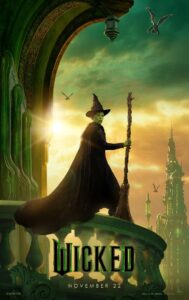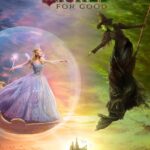
Wicked
The Wicked Witch of the West is dead and the land of Oz celebrates the release of the most evil of creatures. Even Glinda, the Good Witch of the North, shows up to set fire to the puppet of her arch rival. Yet there was a time when the two not only did not hate each other, but were actually best friends. A distant time, dating back to when they first met, at the University of Shiz. Glinda (who was then called Galinda) dreamed of studying with the dean of witchcraft studies, Madame Morrible, but the professor had her eyes on Elphaba, a girl who had no friends because of her green skin, but already had great and uncontrolled powers.
The film is a long but rapid alternation of bright colors, vibrant highs, archetypal premises and developments still hidden behind the curtain, to discover which we will have to wait a whole year.
Why does evil exist? With this question, entrusted to a young girl from the land of the Munchkins, begins the story of Elphaba’s parable, born strange but good, and immediately struck by her father’s rejection, offended by the reaction of her peers in the face of her diversity, blamed for her sister’s misfortune, marginalized like a Joker, emotionally neglected, left alone with her own hypersensitivity, which soon and irremediably began to take over. On the other side of the room, in the college, just like in the attic of Wednesday and Enid, there is her counterpart, Glinda: blonde, vain, ostentatiously good and above all POPular.
Do the quotes and references crowd your mind? Of course: Shiz is a differently scenographic copy of Hogwarts, Nevermore, Cacle’s and above all the Academy of Good and Evil from the film of the same name by Paul Feig. But even the Fantastic Beasts saga hovers like a specter over Jon M. Chu’s work: a liberticidal and intolerant ideological movement is in fact demonizing the animals of Oz, who begin to disappear one after the other, are removed from their chairs, deprived of speech, persecuted and caged. Their teachings are replaced with those of more easily controllable teachers, who invite young people not to look to the past, so that they do not discover that witch hunts are a recurring practice, that diversity is scary, that power, to feed itself, always needs a scapegoat.
Cynthia Erivo and Ariana Grande are the perfect protagonists of the Oz universe: incarnations of two complementary colors, which cannot mix or they would get lost, but they perfectly account for a polarized universe, of perennial opposing fronts, whether it is clothing or moral values. A mirror of our times. Elphaba, forced to mature quickly, makes her choice first, rejects the childish dream of being like everyone else and embraces her identity, making it a strength; in parallel, Glinda’s identity, so apparently sure of her precise shade of pink, begins to falter.








